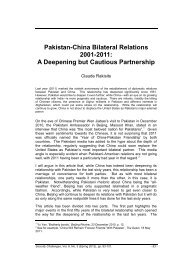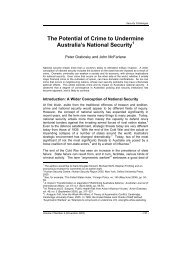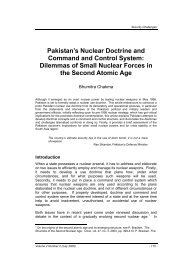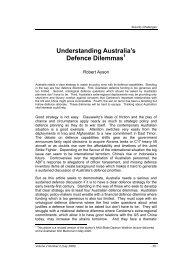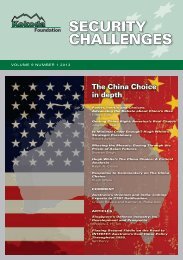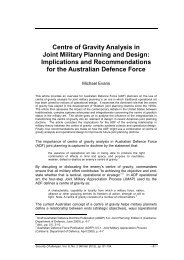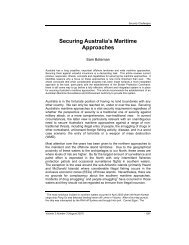The Transformation of Triad - Security Challenges
The Transformation of Triad - Security Challenges
The Transformation of Triad - Security Challenges
You also want an ePaper? Increase the reach of your titles
YUMPU automatically turns print PDFs into web optimized ePapers that Google loves.
Roderic Broadhurst and Lee King Wa<br />
1967/1968. 111 HKP methods <strong>of</strong> counting triad-related <strong>of</strong>fences varied over<br />
the period and are not entirely comparable until the late 1960s. For<br />
example, in the immediate post-war period deportation <strong>of</strong> suspected triads<br />
was common and arrests for triad membership were usually associated with<br />
other criminality. Reports or arrests for unlawful assembly and acting for a<br />
triad were sometimes included or counted separately and reporting periods<br />
shifted from fiscal to calendar year. 112<br />
In 1958 the establishment <strong>of</strong> the specialist and intelligence focused <strong>Triad</strong><br />
Society Bureau 113 within the HKP had a significant impact but was soon<br />
challenged by growing evidence <strong>of</strong> systemic corruption within the HKP linked<br />
to triads. 114 A widespread lack <strong>of</strong> confidence in the police capacity to deal<br />
with corruption and concerns about public disorder engendered by triads<br />
lead to the creation in 1974 <strong>of</strong> a specialist agency outside the HKP to<br />
investigate bribery and corruption: the Independent Commission Against<br />
Corruption (ICAC). 115<br />
During the initial phase <strong>of</strong> the second anti-triad campaign following the<br />
establishment <strong>of</strong> the ICAC, over 14,000 arrests (14,269) for membership<br />
<strong>of</strong>fences alone were recorded from 1974 to 1977. By 1978 the Royal Hong<br />
Kong Police (RHKP) could assert that, “<strong>Triad</strong> societies exist largely in name<br />
only, having degenerated from strictly controlled, politically motivated<br />
organisations into loose-knit gangs <strong>of</strong> criminals that merely usurp the names<br />
<strong>of</strong> triad societies <strong>of</strong> the past”. 116 <strong>The</strong> apparent fragmentation <strong>of</strong> the triads<br />
was not permanent and by the 1980s a reassessment was underway, in part<br />
111 Lethbridge, Hard Graft in Hong Kong: pp. 71-3; Traver, ‘Controlling <strong>Triad</strong>s and Organized<br />
Crime in Hong Kong’, p. 3; In the period 1948-1951 police noted the impact <strong>of</strong> the collapse <strong>of</strong><br />
the Nationalist government with the arrival <strong>of</strong> “formidable formations” <strong>of</strong> the northern and<br />
Shanghai ‘Green Pang’ triads and reinforcements <strong>of</strong> ‘Red Pang’ triads from Canton; see Hong<br />
Kong Annual Report by the Commissioner <strong>of</strong> Police for the year ended the 31st March, 1950,<br />
Government Printer, HK, p. 21.<br />
112 See variously: Annual Report on Hong Kong Police Force, 1946-1947 (Appendix Z); Report<br />
<strong>of</strong> the Commissioner <strong>of</strong> Police For the Year 1948-49; Hong Kong Annual Report by the<br />
Commissioner <strong>of</strong> Police for the year ended the 31st March, 1950; Annual Departmental Report<br />
by the Commissioner <strong>of</strong> Police for the Financial Year 1950-1; and thereafter Annual Reports <strong>of</strong><br />
the Commissioner <strong>of</strong> Police, Government Printer, HK.<br />
113 <strong>The</strong> <strong>Triad</strong> Society Bureau was reformed in 1978 to address serious triad crime and was<br />
incorporated into the new Organized Crime Bureau in 1979. In 1983 the <strong>Triad</strong> Society Division<br />
was disbanded and the Organized and Serious Crime Group was established and later in 1991<br />
reformed as the Organized Crime and <strong>Triad</strong> Bureau. <strong>The</strong>re was speculation that the unit was<br />
disbanded due to the efforts <strong>of</strong> a senior <strong>of</strong>ficer who may have been triad-related.<br />
114 T. S. Cheung and C. C. Lau, ‘A Pr<strong>of</strong>ile <strong>of</strong> Syndicate Corruption in the Police’, in Lee (ed.),<br />
Corruption and its Control in Hong Kong, pp. 199-221; Lethbridge, Hard Graft in Hong Kong; A.<br />
Wu, ‘Hong Kong’s Fight Against Corruption Has Lessons for Others’, Hong Kong Journal, no. 2<br />
(April 2006), [Accessed 9 May 2009].<br />
115 Wu, Ibid.; Traver, ‘Controlling <strong>Triad</strong>s and Organized Crime in Hong Kong’.<br />
116 Annual Report <strong>of</strong> the Commissioner <strong>of</strong> Police 1978 cited in Traver, ‘Controlling <strong>Triad</strong>s and<br />
Organized Crime in Hong Kong’, p .4 and repeating claims made by previous Commissioners—<br />
see Annual Report <strong>of</strong> the Commissioner <strong>of</strong> Police 1965-1966, Government Printer, HK.<br />
- 16 - <strong>Security</strong> <strong>Challenges</strong>



